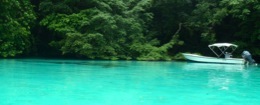We recently received a grant from the NSF program Dimensions of Biodiversity (http://www.nsf.gov/awardsearch/showAward.do?AwardNumber=1241255) to examine and integrate taxonomic, genetic, and functional diversity within and among marine microbes, algae, invertebrates, and fishes in marine lake ecosystems. Marine lakes formed as melting ice sheets raised global sea level >100 m after the last glacial maximum and inundated hundreds of inland valleys around the world. These island-like habitats were inoculated with marine life from the surrounding sea, and then isolated to varying degrees for the next 6000-15000 years—thereby providing multiple millennia-long independent evolutionary ecological experiments into the taxonomic, genetic, and functional dimensions of biodiversity. The long history of each lake is recorded in sediments on the lake bottom, and these sediment layers will be cored to examine how environmental conditions and the species inhabiting each lake varied through time.
Our focus is on marine lakes in Indonesia and Palau; the most famous of these is Jellyfish Lake, which holds millions of (nearly) stingless jellyfish (see picture above). Our project examines the underlying processes that create such ecosystems. It asks whether these processes extend across different types of diversity (i.e. genes, species, and ways of living), different domains of life, and from land to sea.
Through extensive sampling, sequencing, analysis, and modeling with our collaborators, we will determine the extent to which deterministic (e.g. selection) and stochastic (e.g. drift) processes collectively influence the diversity of species, genes, and function and their interactions. The project will: [1] test whether genetic and species diversity increase and decrease in parallel, and [2] whether they do so for both microbes and macrobiota; [3] relate ecological with evolutionary patterns by integrating processes across time-scales; and [4] explore functional causes and consequences of taxonomic and genetic diversity. Models will integrate dimensions of biodiversity and explore how intrinsic and extrinsic factors shape natural populations and communities. This research aims to discover parallel processes that link the three dimensions of biodiversity across microscopic organisms and macrobiota, and unite marine evolutionary patterns with general ecological theory.
More info on marine lakes from Mike Dawson, project PI:
http://marinelakes.ucmerced.edu
Press releases:
http://www.nsf.gov/news/news_summ.jsp?cntn_id=125495&org=NSF&from=news
http://www.ucmerced.edu/news/national-science-foundation-grant-supports-biodiversity-research
Photos:
Top left: lagoon outside Big Crocodile Lake in Palau; photo by Jesse Wilson
Lower left: in and out view of Palau; photo by Mike Beman
Right: Jellyfish Lake, Palau; photo by Mike Beman
The views expressed on this page do not necessarily reflect those of the US National Science Foundation



